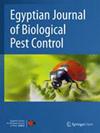Antagonistic fungal volatiles as potential biocontrol countermeasure for microbial postharvest fruit diseases
IF 2.1
3区 农林科学
Q1 ENTOMOLOGY
引用次数: 0
Abstract
Abstract Background Fruits are the main important agricultural commodity, but very susceptible in terms of postharvest losses (PHL) due to diseases by microbial pathogens. Recently, there has been increased interest in countermeasure efforts to reduce PHL. As an alternative to chemical pesticides, fungal volatile organic compounds (FVOCs) are potential countermeasures because they are considered more environmentally friendly with less toxicity to human health. Main body FVOCs include wide diverse of organic chemical functional groups, but with low molecular weight (< C20) which possesses sufficient chemical, physical, and biological properties that can be clearly perceived by other organisms through intra- or inter-kingdom interactions, either mutualistic or antagonistic. Based on the antagonistic function, some beneficial FVOCs can be utilized as a biological control agent and biofumigant to combat microbial pathogens in postharvest fruit. Proposed mechanisms of the antagonistic effect of FVOCs toward their cell counterpart include alteration of the morphology of cell wall and cell membrane, influencing intracellular redox balance, elevating reactive oxygen species (ROS) level, and also possibly damaging DNA target. All these conditions potentially disrupt cell contents and then lead to cell death. In order to achieve this purpose, the suitable formulation of FVOC-loaded biofumigant is very crucial. Conclusion FVOCs have potential application as biofumigant to control microbial pathogens in postharvest fruits. However, for the development of a product, the formulation of FVOC-loaded biofumigant should consider the compatibility of the formula with fruits, toxicity effect to humans, and cost production to ensure the effectiveness of the formula.拮抗真菌挥发物作为果实采后微生物病害的潜在生物防治对策
摘要背景水果是主要的重要农产品,但由于微生物病原菌引起的疾病,水果在采后损失(PHL)方面非常敏感。最近,人们对减少PHL的对策越来越感兴趣。真菌挥发性有机化合物(FVOCs)作为化学农药的替代品,被认为对环境更友好,对人体健康的毒性更小,是潜在的对策。主体挥发性有机污染物包括多种有机化学官能团,但分子量较低(<C20),它具有足够的化学、物理和生物特性,可以通过相互作用或相互作用被其他生物清楚地感知,无论是互惠的还是对抗的。基于其拮抗作用,一些有益的挥发性有机化合物可以作为生物防治剂和生物熏蒸剂来对抗采后果实中的微生物病原体。FVOCs对其细胞对应物的拮抗作用机制包括改变细胞壁和细胞膜的形态,影响细胞内氧化还原平衡,提高活性氧(ROS)水平,并可能破坏DNA靶点。所有这些情况都可能破坏细胞内容物,然后导致细胞死亡。为达到这一目的,选择合适的含氟挥发性有机化合物的生物除菌剂是至关重要的。结论FVOCs作为生物熏蒸剂在水果采后微生物病原控制中具有潜在的应用价值。然而,对于一个产品的开发,负载fvoc的生物熏蒸剂的配方应考虑配方与水果的相容性、对人体的毒性效应和生产成本,以保证配方的有效性。
本文章由计算机程序翻译,如有差异,请以英文原文为准。
求助全文
约1分钟内获得全文
求助全文
来源期刊
CiteScore
4.90
自引率
16.70%
发文量
128
审稿时长
>12 weeks
期刊介绍:
The Egyptian Journal of Biological Pest Control is a periodic scientific journal published by the Egyptian Society for Biological Control of Pests (ESBCP) in collaboration with SpringerNature. The journal aims to publish internationally peer-reviewed, high-quality research articles in the field of biological and integrated pest control (non-chemical control). The journal publishes review articles, original papers, conference reports, book reviews, editorials, laboratory reports, technical notes and short communications.

 求助内容:
求助内容: 应助结果提醒方式:
应助结果提醒方式:


